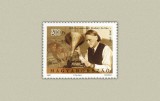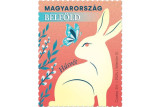
1. MAGYAR - 125 ÉVE SZÜLETETT KODÁLY ZOLTÁN - Bélyeg rendelési kód: 2007 év bélyegei kompletten
2. ENGLISH - ZOLTAN KODALY BORN 125 YEARS AGO - Order code of the stamp: 2007 Year stamps complete
3. GERMAN - Zoltán Kodály wurde vor 125 Jahren geboren - Marke die sprechstunde kode: 2007 Jahr Briefmarken komplett
1. MAGYAR - 125 ÉVE SZÜLETETT KODÁLY ZOLTÁN
A Magyar Posta alkalmi bélyeg kibocsátásával köszönti Kodály Zoltán születésének 125. évfordulóját.
Kodály Zoltán (Kecskemét, 1882. december 16. – Budapest, 1967. március 6.) zeneszerző, zenetudós, zeneoktató, népzenekutató, az MTA tagja.
1900-ban kezdte tanulmányait a budapesti konzervatóriumban, ahol 1904-ben végzett. 1905-ben a Pázmány Péter Tudományegyetemen a tanári oklevelet is megszerezte. Itt ismerkedett meg, és kötött barátságot Balázs Bélával is. Bartókkal együtt népzenét gyűjtve beutazta a magyar vidéket. 1906-ban hozták nyilvánosságra első népzenei gyűjtésüket. 1907-ben a Budapesti Zenei Főiskola professzora lett.
1923-ban Bartókkal együtt megbízást kapott, hogy ünnepi zenét szerezzen Buda és Pest egyesülése 50. évfordulójának ünnepségére. Az eredmény a tenorra, kórusra és zenekarra írt Psalmus Hungaricus volt, ami a zeneszerzőnek 1926-ban nemzetközi hírnevet hozott.
1926-ban volt Háry János című daljátékának bemutatója. 1930-ban szerezte a Marosszéki táncok című művet, 1932-ben a Székelyfonót, 1933-ban a Galántai táncokat, 1936-ban a Budavári Te Deumot, 1939-ben a Concertót.
1943-ban az MTA tagja lett. 1946-1949-ig az akadémia elnöke. Ugyanebben az időszakban hangversenykörutat tett külföldön. 1959-ben, első felesége, Sándor Emma halála után feleségül vette Péczely Saroltát. 1966-ig járt külföldi előadókörutakra, megérte a Magyar Népzene Tárának első megjelenését is. Az elvei szerinti mindennapos énekoktatást Budapesten 120 iskolában vezették be.
Kodály Zoltán zenei nevelési koncepciója ma a magyar zenei köznevelés alapját jelenti, jelentős szerepe van a szakoktatásban is. Ezek az alapelvek fokozatosan alakultak ki, fogalmazódtak meg és kerültek át a gyakorlatba.
A bélyegképen – a több évtizedes tudományos gyűjtőmunkára utalva – a gramofonnál dolgozó Kodály Zoltán látható. Az alnyomaton a zeneszerzőre, illetve a zeneszerzésre utaló kottarészlet található, a háttérben énekelő emberek szerepelnek. A bélyeghez tartozó alkalmi borítékon a művész tanítóként látható, amint épp kottát ír a táblára, a háttérben gyermekkórus énekel. Az alkalmi bélyegző grafikáját a szolmizációs jelek stilizált rajza alkotja.
Megjelenési időpont: 2007. július 16.
Forrás: Philatelia Hungarica Kft., Magyar Posta
2. ENGLISH - ZOLTAN KODALY BORN 125 YEARS AGO
Magyar Posta celebrates the 125th anniversary of the birth of Zoltán Kodály with the issue of a special stamp.
Zoltán Kodály (born Kecskemét, 16 December 1882 – died Budapest, 6 March 1967) composer, scholar of music, music instructor, folk music researcher and member of the Hungarian Academy of Science. He started his studies in 1900 in the Budapest Conservatory and graduated in 1904.
In 1905 he acquired his teaching diploma from the Pázmány Péter University. It was here that he became acquainted and made friends with Béla Balázs. He travelled with Bartók all over where Hungarians lived collecting folk music. In 1906 they published their first folk music collection.
In 1907 he became professor of the Budapest Music Academy. In 1923 Bartók and he received a commission to compose music for the celebration of the 50th anniversary of the joining of the cities of Buda and Pest. The result was the Psalmus Hungaricus written for tenor, choir and orchestra, which brought international fame for the composer in 1926. 1926 saw the premier of the musical play entitled Háry János.
In 1930 he composed the work entitled the “Dances of Marosszék”, in 1932 “Székelyfonó”, in 1933 the “Dances of Galánta”, in 1936 the “Buda Castle Te Deum” and in 1939 “Concerto”. He became a member of the Hungarian Academy of Sciences in 1943, and from 1946 to 1949 was the chairman of the Academy.
In the same period he toured abroad giving concerts. In 1959, after the death of his first wife, Emma Sándor, he married Sarolta Péczely. Up to 1966 he travelled abroad touring, and even lived to see the first publishing of the Hungarian Folk Music Collection.
The every day music teaching carried out according to his principles was introduced in 120 schools in Budapest. The musical education concept of Zoltán Kodály today forms the foundation of Hungarian public music education, and even has a significant role in higher education. These basic principles were developed and formed gradually, and then put into practice. (Source: www.hu.wikipedia.org)
The stamp design – referring to his academic collecting work covering several decades – shows Zoltán Kodály working at the gramophone. The background print shows a piece of written music referring to the composer and the act of composing, also in the background people can be seen singing. On the first day cover belonging to the stamp the artist can be seen as a teacher as he is writing a piece of music on a blackboard, in the background there is a children’s choir singing. The graphic design of the special cancellation stamp shows a stylised drawing of the solmization signs.
Date of issue: 16 July 2007
3. GERMAN - Zoltán Kodály wurde vor 125 Jahren geboren
Die Ungarische Post Briefmarkenausgabe gelegentliche begrüßte die Geburt von Zoltán Kodály's 125. Jubiläum.
Zoltán Kodály (Kecskemét, 1882. 16. Dezember - London, 1967. April, 6), Komponist, Musikwissenschaftler, zeneoktató, Volksmusik, ein Mitglied der MTA.
Im Jahre 1900 begann er Studien an der Budapester Musikhochschule, wo er im Jahr 1904. Im Jahr 1905, die Peter Pazmany Universität erwarb auch ein Diplom in der Lehre. Dort traf er und befreundete Bela Balazs. Bartók mit der ungarischen Volksmusik genannt "reiste die Landschaft. Im Jahre 1906, Volksmusik wurde zum ersten Mal veröffentlicht gyűjtésüket. Im Jahr 1907 Professor an der Budapester Musikhochschule Lettisch.
Im Jahr 1923 wurde mit Bartók, festliche Musik beauftragt, die Fusion von Buda und Pest 50. bekommen Jubiläum. Das Ergebnis ist ein Tenor, Chor und Orchester geschrieben Psalmus Hungaricus, das der Komponist im Jahre 1926 war, hat einen internationalen Ruf.
1926 wurde er daljátékának Hary Janos Präsentation. Im Jahr 1930 erzielte die Tänze Marosszék Arbeit aus dem Jahr 1932, die Székelyfonót 1933 in Polnisch, Tanz, 1936, das Te Deum, im Jahr 1939, das Konzert.
Im Jahre 1943, Lettisch Mitglied des MTA. 1946-1949 durch den Präsidenten der Akademie. Im gleichen Zeitraum hangversenykörutat im Ausland. Im Jahr 1959, die erste Frau von Alexander nach seinem Tod heiratete er Emma Peczely Charlotte. Bis 1966 war ausländischen előadókörutakra dem Erscheinen der ersten Fälle vor dem ungarischen Volksmusik ebenso zu verstehen. Énekoktatást Einklang mit den Grundsätzen der Tag in Budapest wurde in 120 Schulen eingeführt.
Kodály-Konzept der musikalischen Bildung heute die ungarische musikalische Grundlage für die öffentliche Bildung, der beruflichen Bildung hat eine wichtige Rolle. Diese Grundsätze haben sich allmählich entwickelt, formuliert und in der Praxis.
Die Briefmarke - die Jahrzehnte der wissenschaftlichen Sammlung, die sich auf - die Bearbeitung gramofonnál Kodály sichtbar. Der Komponist der Druck-und Hintergrund, aus denen die Fundstelle kottarészlet, Menschen im Hintergrund singen. Die Briefmarken werden gelegentlich sichtbare Hülle des Künstlers als ein Lehrer, so wie die irische Gäste auf dem Brett zu singen die Kinder im Hintergrund. Die gelegentliche Stempel der Grafik besteht aus Zeichnungen von stilisierten szolmizációs Signale.


